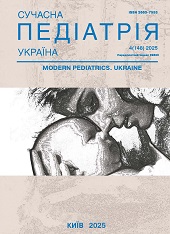Sleep disorders in children with recurrent acute respiratory diseases and background lymphadenoid hypertrophy
DOI:
https://doi.org/10.15574/SP.2025.4(148).4752Keywords:
children, sleep, lymphadenoid hypertrophy, acute respiratory diseases, apneaAbstract
Episodes of acute respiratory diseases are the most common cause of sleep disturbance in young children. Lymphadenoid hypertrophy (LAH) plays an important role in the formation of recurrent respiratory pathology, which creates a mechanical obstacle to airflow and leads to the development of obstructive sleep apnea syndrome (OSAS). Obstruction, hypoxia cause numerous awakenings and contribute to significant metabolic, cardiovascular and neurocognitive disorders.
Aim - to study the features of clinical and somnographic sleep disorders in children with recurrent acute respiratory diseases (RARD) and to establish their dependence on the presence of background lymphadenoid hypertrophy.
Materials and methods. 30 children with recurrent acute respiratory diseases (RARD) without manifestations of LAH, 30 children with RARD on the background of LAH and 20 somatically healthy children were examined. The average age of the children was (6.4±0.6) years, which was comparable between the groups. A questionnaire was conducted with parents regarding sleep disorders in children.
Results. Analysis of questionnaires showed that children with background LAH had pronounced nocturnal symptoms of pharyngeal obstruction such as snoring, pauses in breathing, difficulty breathing, frequent awakenings. The consequence of nocturnal sleep disorders were daytime symptoms (sleepiness, psychoemotional problems). In general, such disorders were detected in 26.6% of children with RARD and 76.6% of children with concomitant LAH. At the second stage, all children with sleep disorders underwent polysomnography, which established the development of nocturnal apnea and hypoventilation syndrome during sleep, while the apnea-hypopnea index was (9.2±2.6) episodes/h in children with LAH versus (2.2±0.6) in children without LAH.
Conclusions. Children with RARD and background lymphadenoid hypertrophy have a significant risk of developing obstructive sleep apnea syndrome. For screening diagnostics of this syndrome, it is advisable to use questionnaires that allow to identify night and day symptoms of upper airway obstruction. The presence of apnea and hypopnea and, as a result, the development of hypoxemia generates a considerable number of clinical symptoms and syndromes and worsens the quality of life of children and their families in general.
The study was performed in accordance with the principles of the Declaration of Helsinki. Informed consent of the child's parents was obtained for the study.
The authors declare that there is no conflict of interest.
References
Abrahamyan L, Sahakyan Y, Chung S, Pechlivanoglou P, Bielecki J, Carcone SM et al. (2018). Diagnostic accuracy of level IV portable sleep monitors versus polysomnography for obstructive sleep apnea: a systematic review and meta-analysis. Sleep Breath. 2(3): 593-611. https://doi.org/10.1007/s11325-017-1615-1; PMid:29318566
Chan KC, Au CT, Hui LL et al. (2019). How OSA evolves from childhood to young adulthood: natural history from a 10-year follow-up study. Chest. 156: 120-130. https://doi.org/10.1016/j.chest.2019.03.007; PMid:30922948
Cynoverska OB, Lazurkevych KO. (2020). Son ta yoho porushennia u ditei: medyko-sotsialni aspekty. Art of medicine. 3(15): 231-237. doi: 10.21802/artm.2020.3.15.231.
Düzer S, Susaman N, Winkler AA. (2021). Tonsillar Hypertrophy in Childhood. Pediatric ENT Infections. URL: https://link.springer.com/chapter/10.1007/978-3-030-80691-0_21#Abs1. https://doi.org/10.1007/978-3-030-80691-0_21
El-Sheikh M, Kelly RJ. (2017). Family Functioning and Children's Sleep. Child Dev Perspect. 11(4): 264-269. https://doi.org/10.1111/cdep.12243; PMid:29731807 PMCid:PMC5931738
Faverio P, Zanini U, Monzani A et al. (2023). Sleep-Disordered Breathing and Chronic Respiratory Infections: A Narrative Review in Adult and Pediatric Population. Int J Mol Sci. 13; 24(6): 5504. https://doi.org/10.3390/ijms24065504; PMid:36982578 PMCid:PMC10052011
Gottlieb DJ, Punjabi NM. (2020). Diagnosis and management of obstructive sleep apnea: A review. JAMA. 323(14): 1389-1400. https://doi.org/10.1001/jama.2020.3514; PMid:32286648
Gulotta G, Iannella G, Vicini C et al. (2019). Risk factors for obstructive sleep apnea syndrome in children: state of the art. Int J Environ Res Public Health. 16(18): 3235. https://doi.org/10.3390/ijerph16183235; PMid:31487798 PMCid:PMC6765844
Kvashnina L. (2020). Rekurentni respiratorni infektsii u ditei: osoblyvosti medychnoho suprovodu. Vashe zdoroviaURL: https://www.vz.kiev.ua/rekurentni-respiratorni-infektsiyi-u-ditej-osoblyvosti-medychnogo-suprovodu.
Kuznietsova OD, Nedelska SM, Kuznietsov AA. (2022). Obstructive sleep apnea syndrome in children as a multi-disciplinary problem (a review). Zaporozhye Medical Journal. 24; 5(134): 591-598. https://doi.org/10.14739/2310-1210.2022.5.257059
Maidannyk VG Gnyloskurenko GV, Aliusef MH. (2019). Sleep disorders in children International Journal of Pediatrics, Obstetrics and Gynecology. 12(2): 33-38.
Matricciani L, Paquet C, Galland B, Short M, Olds T. (2019). Children's sleep and health: A meta-review. Sleep Med Rev. 46: 136-150. https://doi.org/10.1016/j.smrv.2019.04.011; PMid:31121414
Niedzielski A, Chmielik LP, Mielnik-Niedzielska G, Kasprzyk A, Bogusławska J. (2023). Adenoid hypertrophy in children: a narrative review of pathogenesis and clinical relevance. BMJ Paediatr Open. 7(1): e001710. https://doi.org/10.1136/bmjpo-2022-001710; PMid:37045541 PMCid:PMC10106074
Ophoff D, Slaats MA, Boudewyns A, Glazemakers I, Van Hoorenbeeck K, Verhulst SL. (2018). Sleep disorders during childhood: a practical review. Eur J Pediatr. 177(5): 641-648. https://doi.org/10.1007/s00431-018-3116-z; PMid:29502303
Türkoğlu S, Tahsin Somuk B, Sapmaz E, Bilgiç A. (2019). Effect of adenotonsillectomy on sleep problems, attention deficit hyperactivity disorder symptoms, and quality of life of children with adenotonsillar hypertrophy and sleep-disordered breathing. Int J Psychiatry Med. 54(3): 231-241. https://doi.org/10.1177/0091217419829988; PMid:30823857
Downloads
Published
Issue
Section
License
Copyright (c) 2025 Modern pediatrics. Ukraine

This work is licensed under a Creative Commons Attribution-NonCommercial 4.0 International License.
The policy of the Journal “MODERN PEDIATRICS. UKRAINE” is compatible with the vast majority of funders' of open access and self-archiving policies. The journal provides immediate open access route being convinced that everyone – not only scientists - can benefit from research results, and publishes articles exclusively under open access distribution, with a Creative Commons Attribution-Noncommercial 4.0 international license (СС BY-NC).
Authors transfer the copyright to the Journal “MODERN PEDIATRICS. UKRAINE” when the manuscript is accepted for publication. Authors declare that this manuscript has not been published nor is under simultaneous consideration for publication elsewhere. After publication, the articles become freely available on-line to the public.
Readers have the right to use, distribute, and reproduce articles in any medium, provided the articles and the journal are properly cited.
The use of published materials for commercial purposes is strongly prohibited.

